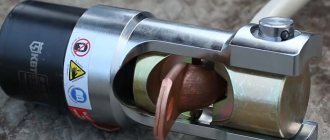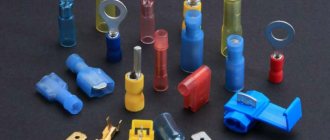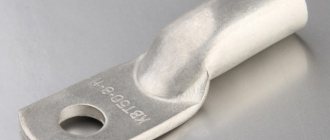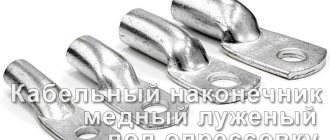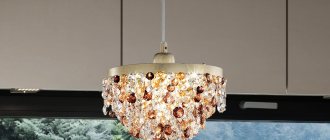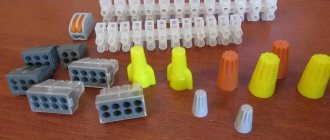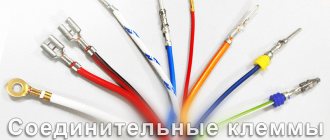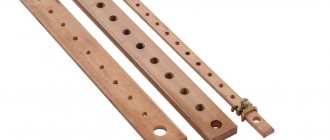The insulated pin sleeve lug (abbreviation NShVI) is designed for crimping stranded copper wires, and allows them to be firmly and quickly attached to any devices or connectors. The end of the cable is crimped using a special tool. This connection does not require much effort and is very reliable. Pliers are often used to clamp the NShVI-tip with screw fixation. In this article we will look at the main types and sizes of NShVI tips, as well as the rules for crimping them.
Insulated pin sleeve lug for wires and its crimping
Single wire type cables are very well suited for distributing 220V power throughout the house. They are rigid, so you can bend them however you want, and because the wire inside is a single rod, without additional tools, using ordinary electrical connectors, it quickly connects to other wires and blocks (for example, in an electrical panel).
Power cords are a completely different story. They are flexible, and inside one wire consists of a dozen or even several dozen thin copper wires. The vast majority of power cords supplied with household appliances and all kinds of extension cords are made using wired multi-core cables.
Using such cables, you can connect two or more wires to one point without using external electrical connectors. For this purpose, cable end sleeves (pin lug) are used and today’s article will be about them. An important advantage of this solution is that the switch has a very good contact surface with the cable or wires.
In addition, the terminals of such a sleeve can be used wherever it is necessary to connect cables such as a network line. Connecting a cable to an electrical connector of a product (module) without a clamped bushing may result in the connector screw pressing only on part of the cable wires, which will weaken reliability and conductivity.
Crimping tool
The tip attached to the conductors using the crimping method is a non-removable connection, therefore, when connecting to other electrical equipment in a different way, it will have to be cut off. The crimping process is a kind of crimping of a bushing with conductors inside. For these purposes, a special tool is used - press pliers. They are equipped with a set of dies for different tip diameters.
Press pliers produce different modifications, and some models are designed to perform two types of work:
- The most common and convenient to use are universal press pliers. They are capable of performing a double function: stripping the insulation from the wire and crimping the bushing. Moreover, in addition to NSHVI, press pliers can cope with other types of tips;
- sometimes press pliers are equipped with an adjustment mechanism that controls the crimping force. This device allows you to avoid accidental pinching of the sleeve;
- press pliers with hinges increase the clamping force of the tool, which facilitates the process of manual crimping;
- Press pliers with a ratcheting mechanism are very convenient to use. It prevents the tool from unclenching until crimping is completed. It often happens that a tool accidentally released loosens the undercompressed bushing in the matrix, and it rotates. The next pressing with the die may not coincide with the grooves from the previous crimping, which will create a poor crimp.
In general, each specialist selects press pliers individually. After all, the quality and speed of work depends on the convenience of the tool.
Insulated pin bushings
The insulated pin sleeve lug for attaching to wires consists of two parts:
- the conductor is a tube several tens of millimeters long. This is the part that will be compressed.
- insulation - a plastic element in different colors and thicknesses, depending on the size of the cable for which the tip is intended.
Of course, they can be purchased in various sizes to perfectly match the cross-section of the cable being crimped. Here is a table of the main characteristics:
It is worth explaining how the different sizes of insulated tips are described. The example of marks in the figure shows:
- HI - Product type as a symbol.
- 2,5 — a terminal designed for clamping a single wire with a maximum cross-section of 2.5 mm2.
- 2 X 2.5 - the terminal is designed to tighten two wires, each of which has a maximum cross-section of 2.5 mm2.
- / 8 — length of the conductive element in millimeters.
So if you see the symbol “HI 2 X 1.5 / 8” in the store, this means that the package contains insulated lugs designed to tighten two wires, each with a maximum cross-section of 1.5 mm2 and a conductive element length of 8 mm.
Please note: on the insulation side, the hole of the single lug is round, and the hole of the double lug is rectangular, so that the two wires can be placed next to each other.
Types, their advantages and disadvantages
At the moment, a fairly large number of NShVI lugs for single-core and multi-core wires made of copper and aluminum are presented on the electrical goods market. The most popular are:
- copper. Ferrules for stranded wires. This is a solid copper capsule. One of its sides is flattened, and the other has a hole for mounting with a bolt. It has two varieties: uncoated with the TM marking and tinned with the TML marking. Together with the abbreviation, the cross-sectional size and diameter of the conductor hole for crimping are indicated. This type can be used to crimp wires from 2.5 to 240 mm². Tinned tubes are used to connect units of increased corrosion resistance;
- copper with control window. These tips are less popular, and many specialists do not encounter them during the entire period of work. It is easy to distinguish them from ordinary ones - the letter “O” is added to the marking. In appearance they are similar to ordinary ones, but they have a control window through which observation takes place;
- aluminum. Ideal for crimping cable cores made of aluminum. They are marked with the abbreviation “TA”, and in appearance they are similar to copper samples. The cross-section for which such tips are used starts from 16 mm²;
- pin insulated. This is a kind of sleeve that is designed to insert the bare wire into the sleeve and then crimp it using special pliers.
Aluminum NShVI for large sections
Important! Do not use pliers or a hammer for crimping. Crimping is carried out with special press pliers. They are made in different types: hydraulic for large cross-section wires and manual for smaller diameter cables.
In practice, such types are rarely distinguished. Typically, NSHVIs are divided into single and double. The main advantage of the second type is that you can press two stranded wires at once. Such lugs are used instead of wire jumpers to supply current to automatic type switches. Double sleeves are used for cables that fit into one socket of an electrical device. Single ones differ in that they have a plastic flange. Obviously they are designed for one wire.
Table describing the main characteristics
Advantages of NSHVI:
- lugs provide protection of the current conductor from mechanical and electrical damage;
- NShVI allow you to securely fix the wire for a long time. No amount of insulating tape can compare with them;
- tips, which are made with cuffs of different colors, can mark pressed conductors;
- Double-type NSHVI greatly facilitates the laying of a pair of cables to one clamp.
You might be interested in Heating cable for heating pipes
Note! The main disadvantage is that it is necessary to select a tip for a certain cross-section. If a larger or smaller diameter is used, serious safety problems may arise.
The advantage of NSHVI is their versatility
Crimper for pin bushings
The pin lug crimp consists of a series of indentations and tabs, each of a different size. Each hole is used to clamp bushings of a different size.
Each hole has a number that determines what cable section the hole is intended for. For example, this crimp can clamp wires with a cross section from 0.5 mm to 16 mm square.
Technical specifications
The technical parameters of NShVI tips depend on their type, insulation color, range of sections and sizes.
Parameters by which technical characteristics are determined
The figure shows a diagram for determining the main parameters of the tip, and the one below shows a table that corresponds to these values.
Table with the main parameters of NSHVI
Other types of crimping tools
Crimping tools from different manufacturers have their own shape, but when it comes to the most convenient option, let's note the automatic crimper.
Such a device does not require searching for the hole that best fits a given tip. There is one hole and during clamping it automatically adjusts to the inserted end of the coupling and the clamps.
On various websites and online stores, this type of crimping machine is called universal, but the range of conductor cross-sections it supports is usually limited, for example from a cross-section of 0.25 to 6 mm2 or from 6 to 16 mm2. More versatile, in terms of the range of wire cross-sections, are hand crimpers like the one shown above.
Double terminal crimp
The connection of more than one conductor to a phase most often occurs on one contact. For example, when installing modular type circuit breakers, mutual connections are made using jumpers. Thus, two conductors come to one contact. When using single lugs, a problem arises in connecting two pins to one switch contact. In this case, it is more advisable to use NShVI lugs for dual-type wires.
The pressing process is similar to that when using a single tip. The only difference is the insertion of two conductors into the wide “cuff”. For double pressing, a crimper device is used. Can also be used for single spin. The matrices are large in size.
If a double lug is not available for installation, you can use a single lug with a larger bushing diameter, provided that both conductors must fit inside.
How to crimp a pin lug
This is a simple operation. Just do it once and you can consider yourself an expert on this topic. It may take two or three tries, but let's start from the beginning. Let's look at two examples:
- We will compress a wire with a cross section of 2.5 mm2 using a 2.5 / 8 sleeve
- Let's fasten two conductors at one end: one 2.5 mm, the second section 1.5 mm2 using a 2 x 2.5 / 10 sleeve
Crimping a single bushing with a wire
First of all, we remove the insulation from the test 3-core cable with a cross section of 2.5 mm. It is better to use an insulation stripper, but you can do it the classic way - using a knife.
After removing the overall outer insulation, strip the insulation from the end of each wire separately. It is worth stripping the insulation to the same length as the length of the sleeve, which in this case is 8 mm.
Now all you need to do is put the sleeve (tube) on the end of the wire. Ideally, the sleeve insulation will match the wire insulation.
It is not acceptable to place the ferrule so that the copper wires between the wire insulation and the ferrule insulation are visible. Such a connection is both unreliable and unsafe!
Now you need to insert the sleeve into the hole of the tool of the required size and compress it. We find 2.5 on the crimping device and insert it to the end of the tube with the wire, then press the handle and everything is done.
You can check whether the lug is securely seated on the wire by holding the cord with one hand and pulling the cable with the other. You may have to apply more pressure if the tip moves.
Double Pin Lug Crimping
Clamping two wires at one end requires the use of a double terminal for the given cable cross-section.
The first step is identical. Remove the insulation from the ends of both wires. The double lug we'll be putting on has a sleeve length of 10mm, so will require a little more insulation than before. Holding both wires parallel to each other, insert them into the end of the sleeve. There is no need to pre-twist the cables together. Slowly (so as not to become disheveled) we put the tip on the wires.
Types of tips
There are several types of NSHVI, differing in the number of connected wires. One or two wires can be connected to the product, but the exiting metal part, intended for clamping with a screw terminal, remains one. The double tip in the designation has the number 2 after the letters NSHVI.
If we consider the design, the NShVI double-connection sleeve terminals have the same structure as their single counterparts. The same metal part for crimping and PVC cuffs. The double model differs only in the wider width of the PVC skirt, since it is designed for two wires.
The use of double lugs is necessary when connecting two wires to one terminal. This frequent need arises during the installation of sockets and circuit breakers in an electrical panel. Crimping of double models is identical to single ones, and the same tool is used - press pliers.
Twisting wires before crimping
Now about twisting the wires. Some people do this every time because once it's done, it's easier to push the wires into the end pin (tube).
Of course you can do this, the effect is ultimately identical.
But when twisting wires, it is a mistake to screw them in one at a time and then try to twist them together. Cables with this twist have a larger cross-section and may not fit into the grommet hole.
Preparatory work before crimping
Crimping of wires begins with preparatory work:
- First of all, the conductors are cleared of insulation. It is removed exactly along the length of the metal part of the tip. To do this, use press pliers with a stripping function or a sharp knife. There is also a special tool - a stripper, which automatically removes the insulation;
- The metal part with the cuff has a flared edge at the edge, which improves the entry of the cores into the seat. But to prevent some of the wires from bending to the sides when inserted, the wires are slightly twisted by hand;
- The sleeve is selected according to its cross-section so that the cores fit freely into the socket, but do not dangle too freely;
- Now it's time to prepare the press pliers for crimping. When picking up a tool for the first time, you need to pay attention to the color markings applied. It matches the colors of the tips. Manufacturers of tools and bushings try to maintain a color standard to facilitate similar connections. The color designation indicates the correspondence of the diameters of the pliers matrix and the bushing; therefore, for example, crimping a blue tip must be done with a matrix socket marked in the same color.
Having sorted out the tool and prepared all the materials for work, they begin crimping.
Options for crimping bushings
You can use wires with other cross-sections of lugs. You don't always have all types of bushing terminals on hand. For example, to clamp one 1.5 mm² wire, you can use a 2 x 0.75 ferrule. Of course it's not professional because the tip insulation doesn't fit perfectly, but in most cases it gets the job done just fine.
When it is necessary to clamp, for example, three wires, it is worth using one terminal with a correspondingly large cross-section. The single lug has a round insulation shape which will be better for three conductors than square insulation. For example, we want to connect three wires with cross sections: 2.5 mm2 - 2 pcs. and 1.5 mm2 - 1 pc. It's worth trying to use one terminal for 6mm2 wires. It should fit perfectly.
Connectors for wires for crimping: types of lugs, sleeves and terminals
There are many options for tips used for crimping. It is imperative to take into account how the wiring will be installed. If the cables are expected to be clamped in a circuit breaker, then it is better to use pin bushings for connection. Tips with or without insulation can be found on sale. The same product option is used for cables that are clamped using contact blocks.
If the wiring will be fastened under a nut-screw, then in this case special connectors are required. These include the following types of terminations: U, J and O. Once installed, the same screw is used to clamp them to the contact pad. There is another class of connections - male-female tips. They are quick-release products that are very convenient to use.
Cable lugs for crimping can be either with or without insulation
Based on the shape of the structure, the following types of wire crimping lugs are distinguished:
- ring;
- power;
- fork;
- tubular (sleeve);
- in the form of a socket (used for quick connection);
- pin.
In addition, tips are classified according to the type of material from which they are made.
Wire lugs: types of products, their purpose
The connecting element is selected taking into account the type of wires on which it will be installed. The most common and in demand are the following types of tips:
- copper;
- aluminum;
- aluminum-copper;
- bolted
Copper versions of the products are intended for crimping cables made of the same material. To produce these parts, seamless tubes are used. On one side of the tip there is a clamping part. On the other side of the connector there is a tubular hole where the wire will be inserted. Purpose of copper tips:
Copper and aluminum lugs are designed for wires made of the same materials as the products themselves
- connection to the circuit of input and distribution devices;
- installation of electrical appliances;
- grounding
Aluminum products, like copper ones, are intended for wires made of the same material. On one side they also have a tubular hole, but on the other side they have a contact blade.
Important! Before connecting the wires with a crimping tool for lugs, aluminum products should be treated with quartz-vaseline lubricant. It will protect the contact area from oxidation.
Sometimes copper bars are used in distributors. In this case, aluminum-copper connectors are used. For these elements, the landing tube is made of aluminum, and the contact blade is made of copper. Frictional diffusion is used in the production of these products. The gas-dynamic copper deposition technology can also be used, during which metal is sprayed over the tip, ensuring stable contact.
Bolt ends are one of the most popular
In bolt-type lugs, fixation is carried out using a clamping bolt. You will need a wrench to tighten it tightly. This method does not require crimping since the bolt itself makes the contact connection.
Main types of crimp lugs for copper wires
During the manufacturing process of copper connectors, the pipes are cut accordingly. After this, a contact blade is formed on one side by flattening. It has a hole for fasteners, the size of which depends on the diameter of the bolt.
There are two types of copper cable lugs:
- without a protective layer;
- with tinned coating.
Tin-plated contacts are much more practical because they have anti-corrosion protection. Thanks to this, this type of product has a long service life. Tin-plated connectors are resistant to the aggressive effects of various acids:
- sulfur;
- nitrogen;
- salty
Copper crimp ends are available with or without puddle coating
They are not destroyed under the influence of moisture, air and other negative environmental factors. Due to the presence of a protective coating, the level of electrical conductivity of the tips is reduced, but this does not prevent them from maintaining optimal performance.
As for copper connectors that do not have a protective coating, the oxidation of these products occurs much faster. Their current conductivity is very low, which increases resistance. As a result, the connection area heats up.
The scope of application of copper tips extends to:
- to create a contact between devices (possible use on a group of devices);
- forming a connection between the device and the electrical network;
- increasing the cable length by splicing wires.
Experts advise using lug crimping pliers to install copper connectors on wires. Despite the extensive selection of products offered by manufacturers, it is not always possible to select an element of the required size. In this case, it is worth making the tip yourself. To do this, select a copper tube of the required size and then flatten it at one end. A hole of the appropriate diameter is made in it for the mounting bolt.
Coated tips are resistant to air and moisture
Important! Tips made in home-made conditions are significantly inferior in their characteristics to factory-made products. It is very difficult to calculate what degree of load they can withstand, so it is not recommended to use homemade connectors in critical sections of the electrical circuit.
Using wire sleeves for crimping
In some cases, wire sleeves can be used as connectors instead of lugs. If splicing of cables in which the conductors are made of copper is required, products marked GML should be used for work. This marking means that the sleeve is made of copper and is protected by a tin-plated coating. Products marked GAO are intended for connecting aluminum wires. They are aluminum sleeves with a closed design. In addition, there are sleeves made from alloys. They are used in cases where it is necessary to connect aluminum and copper elements.
The connection by crimping wires with sleeves or lugs is of better quality than splicing by soldering. A multicore cable consists of several cores, each of which is hidden in its own insulating sheath. For reliable contact, they all must be bare, which creates certain difficulties when using soldering. Such problems do not arise with crimping, because during the compression process the insulating layer on each core is destroyed. This ensures a strong connection and ensures better contact.
If crimping will be carried out using sleeves, it is very important to pay special attention to the selection of products, in particular their material of manufacture. As a rule, current characteristics are written on them. The main difficulties in the process of purchasing products arise when it is necessary to choose the appropriate size. Manufacturers in this regard offer a limited range. In addition, it is difficult for a person without special education to decipher the markings.
The sleeves are ideal for splicing multiple wires
Crimping wires using sleeves is performed in exactly the same way as when using lugs, however, more crimps will be required.
Main types of crimp terminals for wires
Connection terminals can be divided into two categories: electrical and electrical. The difference between these products lies only in the amount of current load that they can withstand. This parameter must be taken into account when selecting terminals for crimping wires during installation or repair of a circuit.
Related article:
Wire lug crimping pliers: types of tools and methods of application
Functional purpose. Professional and household tools. Hydraulic pliers. Crimper for crimping Internet wires.
The most popular types of crimp terminals with the simplest design:
- fork;
- knife;
- pin;
- ring.
Knife-type terminals are the most common option. They are found mainly in household appliances, such as refrigerators, irons or heating devices. Knife terminals are mounted on stranded wires, the cross-sectional size of which is in the range of 0.26-6 mm².
There are crimp terminals: fork, ring, pin and knife
Insulated and non-insulated options are available on sale. The color of the insulating material depends on the design power. It can be yellow, blue or red. Such products are used in pairs (“father and mother”).
Important! The maximum voltage that such a connection can withstand is 5 kW. Therefore, knife terminals cannot be installed in large power plants with high current power. Also, their installation in apartment electrical panels is not allowed.
Fork terminals are used in secondary or power circuits. After their installation, screw fastening to busbars or electrical equipment is assumed. This product option is considered a temporary option. Fork type terminals can be used in areas where contacts are frequently reconnected. Externally, these terminals resemble a plug with two prongs. They are used for crimping wires whose cross-sectional size does not exceed 6 mm². Available in two versions - with and without insulation.
Ring terminals provide very reliable contact. Like fork ones, they are subsequently secured with screws. Due to the fact that the contact part has a round shape, the connection area increases. In addition, the likelihood of the tip popping out is reduced. Suitable for low-current and power networks. Cable cross-sections may vary. Ring terminals come in aluminum, brass, copper-aluminum and copper.
Ring terminals are reliable and come in a variety of materials
Pin terminals have a detachable design consisting of a plug and a socket. Blue products are intended for wires with a small cross-section - up to 2 mm², and yellow ones - from 2 to 6.64 mm².
Crimping the wire and ferrule using improvised means, without a press or special tools.
What to do if you don’t have special tools for crimping on hand or you just don’t want to buy them if you only need to crimp one or two tips?
Many, faced with this problem, resort to incorrect methods, which in the future only worsen the contact, without ensuring a reliable connection.
They begin to flatten the tip with hammers, simply squeeze it in a bench vice, crush it with pliers, and press it in with a chisel. All these methods are incorrect and do not bring the desired result.
After such amateur activity, poor contact is obtained with its further heating during operation.
True, some manage to compress the tip with a hydraulic press so that the wire easily comes out of it, as soon as you pull with a little force.
There are other ways to crimp power wires with lugs using improvised means, which can be found in almost everyone’s garage or home.
The easiest and fastest way is pressing using a center punch. To do this you will need:
- ordinary hammer
The process is very simple and straightforward:
- insert the tip into the wire
In this case, there is no need, as many people do, to first flatten the tip with a hammer. During the strikes this will happen in any case. The number of cores, that is, holes from the impact on the metal, depends on the length of the tip.
At the same time, on the back side of the tip, the crimping points should not be symmetrical to those on the front part, but shifted by a couple of millimeters.
The most important thing is not to perforate the tip and control the impact force. Therefore, if you use a 200mm nail for this, first of all you should dull it.
As a result, you will get sufficient contact, which, of course, is not comparable to crimping with a professional PGR-70 tool, but in the absence of excess loads it will last a long time.
The most important thing in this method is to choose the right cross-section of the wire and tip. The declared cross-section is very often smaller than the actual one.
For reliable contact, the wire must fit tightly inside the sleeve without any slack. Therefore, this point is always checked manually; you should not blindly trust the numbers on the cable sheath and on the tip blade.
There are other simple ways to connect ferrules to wires without using a press. For radio amateurs who have no problems with solders and other devices, ordinary soldering is suitable.
This cannot quite be called crimping, but is still a method of connection without the use of a special crimping tool.
Cable lugs for crimping: main characteristics
Wire lugs (terminals) are universal parts used for contact connection of cables. The use of such products has a positive effect on the functioning of the electrical circuit as a whole. There is a huge range of different types of lugs on the market, so it is not difficult for consumers to choose the appropriate option for performing certain electrical installation work.
Manufacturers offer a wide range of different types of tips
Ferrules for stranded wire allow you to create a reliable connection with various components of the electrical circuit:
- screw clamp;
- terminal block;
- household electrical appliance;
- another cable.
The lugs perform well in circuits where strong vibrations often occur. They can also be used in cases where standard joining methods are not suitable. For example, if the wires are not long enough, soldering or welding cannot be used. To crimp wires in such a situation, a tip or sleeve is simply installed on the bare end, after which this area is crimped.
Advantages of using tips:
- The bundle of veins remains intact, it does not flatten or fall apart.
- The connection area does not burn or heat up.
- The integrity of the wires is maintained.
- Metal conductors are reliably protected from moisture and air.
- All wires of the bundle take part in the transmission of current.
- The tips have a large contact area.
Thanks to the lugs, the bundle of wires remains intact and does not fall apart
Connecting cables using the crimping method is used in production (connecting power lines) and in domestic conditions. The popularity of this method, in contrast to the use of conventional clamps, is due to its high reliability. In addition, connecting wires using a ferrule is much easier than using soldering or welding.
Note! The size of lugs for wires for crimping, as well as sleeves, must be selected taking into account the main characteristics of the wire. These parameters include the diameter of the cable and the type of metal from which it is made.
